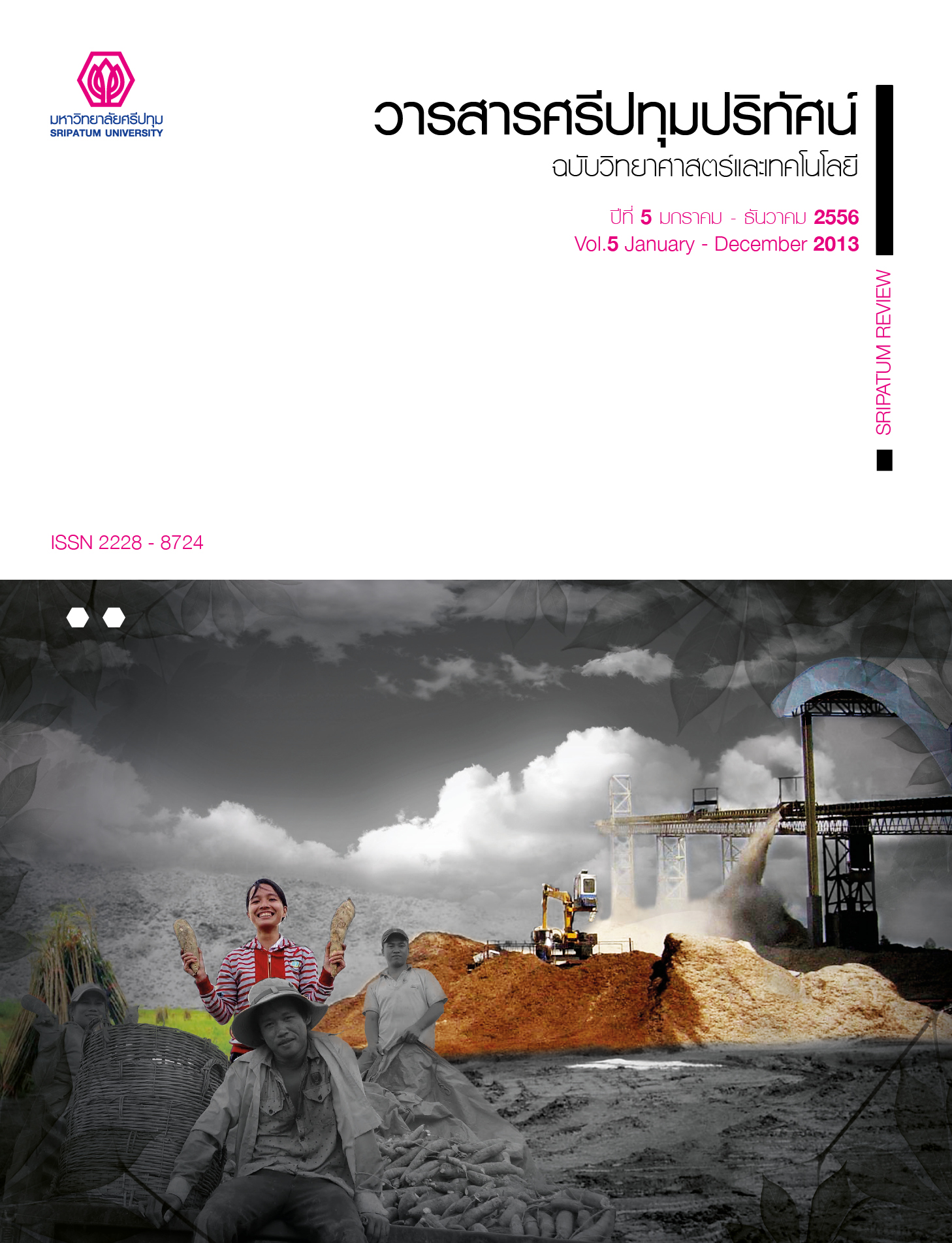การประมาณค่าการเคลื่อนที่ของอาคารคอนกรีตเสริมเหล็ก เนื่องจากแรงแผ่นดินไหว โดยวิธีการผลักแบบวัฏจักร
Main Article Content
บทคัดย่อ
งานวิจัยนี้ เป็นการประเมินค่าการเคลื่อนที่สูงสุดของอาคารคอนกรีตเสริมเหล็กภายใต้แรงแผ่นดินไหว โดยวิธีการผลักแบบวัฏจักร ซึ่งเป็นการจำลองพฤติกรรมของแรงกระทำให้ใกล้เคียงกับคลื่นแผ่นดินไหวจริงมากที่สุด โดยเลือกอาคารเรียนคอนกรีตเสริมเหล็ก สูง 4 ชั้น ซึ่งเป็นอาคารเรียนตามแบบมาตรฐานของกระทรวงศึกษาธิการมาใช้ในการศึกษา แรงกระทำต่ออาคารนั้น ใช้รูปแบบประวัติเวลาของแรงกระทำจำนวน 4 รูปแบบมาทำการวิเคราะห์ผลักอาคารแบบวัฏจักร จากนั้น นำผลที่ได้ไปเปรียบเทียบกับวิธีวิเคราะห์ด้วยการผลักอาคารแบบสถิต และวิธีพลศาสตร์ไม่เชิงเส้น ซึ่งเป็นวิธีการที่ให้ผลใกล้เคียงความเป็นจริงมากที่สุด โดยใช้คลื่นแผ่นดินไหวที่เป็นตัวแทนพื้นที่ภาคเหนือของประเทศไทย จำนวน 10 คู่ ผลการศึกษาพบว่า ค่าการเคลื่อนที่สูงสุดบนยอดอาคาร ค่าการเคลื่อนที่สูงสุดในแต่ละชั้นอาคาร ค่าการเคลื่อนที่สัมพัทธ์ในแต่ชั้นอาคาร และค่าดัชนีความเสียหายที่ได้จากวิธีการผลักแบบวัฏจักร มีค่าความคลาดเคลื่อนเฉลี่ยเมื่อเทียบกับวิธีพลศาสตร์ไม่เชิงเส้น เท่ากับ 11.6, 6.1, 16.5 และ 34.7% ตามลำดับ ซึ่งใกล้เคียงกว่าวิธีการผลักอาคารแบบสถิต เนื่องจากวิธีการผลักแบบวัฏจักรมีรูปแบบของแรงกระทำแบบกลับไปกลับมา ผลตอบสนองที่ได้จึงสอดคล้องกับพฤติกรรมของอาคารภายใต้แรงแผ่นดินไหวจริง และมีค่าที่ใกล้เคียงค่าที่ถูกต้องมากกว่าวิธีการผลักอาคารแบบสถิต
Article Details
เอกสารอ้างอิง
ไพบูลย์ ปัญญาคะโป. 2554. “การประเมินความเสียหายภายใต้แรงแผ่นดินไหวของอาคารสูงโดยวิธีการผลักแบบวัฏจักร.” รายงานการวิจัย. มหาวิทยาลัยศรีปทุม.
American Society of Civil Engineering (ASCE). 2007. Seismic rehabilitation of existing building. ASCE Standard No. ASCE/SEI 41-06
Antoniou, S. Pinho, R. 2004 “Development and verification of a displacement-based adaptive pushover procedure.” Journal of Earthquake Engineering, 8(5) : 643-661
Carr, A.J. 2006. Ruaumoko User Manual, University of Canterbury, New Zealand.
Chopra, A. K. and Goel, R. K. 2002. “A modal pushover analysis procedure for estimating seismic demands for buildings.” Earthquake Engineering and Structural Dynamics. 31 : 561-582
Chopra, A. K. and Goel, R. K. 2005. “Role of higher mode pushover analysis in seismic analysis of buildings.” Earthquake Spectra. 21(4) : 1027-1041
Chopra, A. K., Goel, R. K. and Chintanapakdee 2004. “Evaluation of a Modified MPA procedure assuming higher modes as elastic to estimate seismic demands.” Earthquake Spectra. 20(3) : 757-778
FEMA. 2005. NEHRP Improvement of Nonlinear Static Seismic Analysis Procedures (FEMA 440). Federal Emergence Management Agency, Washington D.C.
Goel, R. K. and Chopra, A. K. 2004. “Evaluation of modal and FEMA pushover analysis; SAC buildings.” Earthquake Spectra. 20(1) : 225-254
Panyakapo, P. 2010. “Seismic Performance of RC Building by Cyclic Pushover Analysis.” The 7th International Conference of Urban Earthquake Engineering (7 CUEE) and The 5th International Conference on Earthquake Engineering (5 ICEE), Tokyo, Japan.
Papanikolaou, V. K., Elnasshai, A. S., Pareja, J. F. 2006. “Evaluation of conventional and adaptive pushover analysis II: Comparative results.” Journal of Earthquake Engineering, 10(1): 127-151
Park, Y. J. and Ang, A. H. 1985. “Mechanistic seismic damage model for reinforced concrete.” Journal of Structure Engineering, ASCE, 111(4): 722-739
Sezen, H. and Chowdhury, T. 2009. “Hysteretic Model for Reinforced Concrete Columns Including The Effect of Shear and Axial Load Failure.” Journal of Structure Engineering, ASCE, 135(2): 139-146


